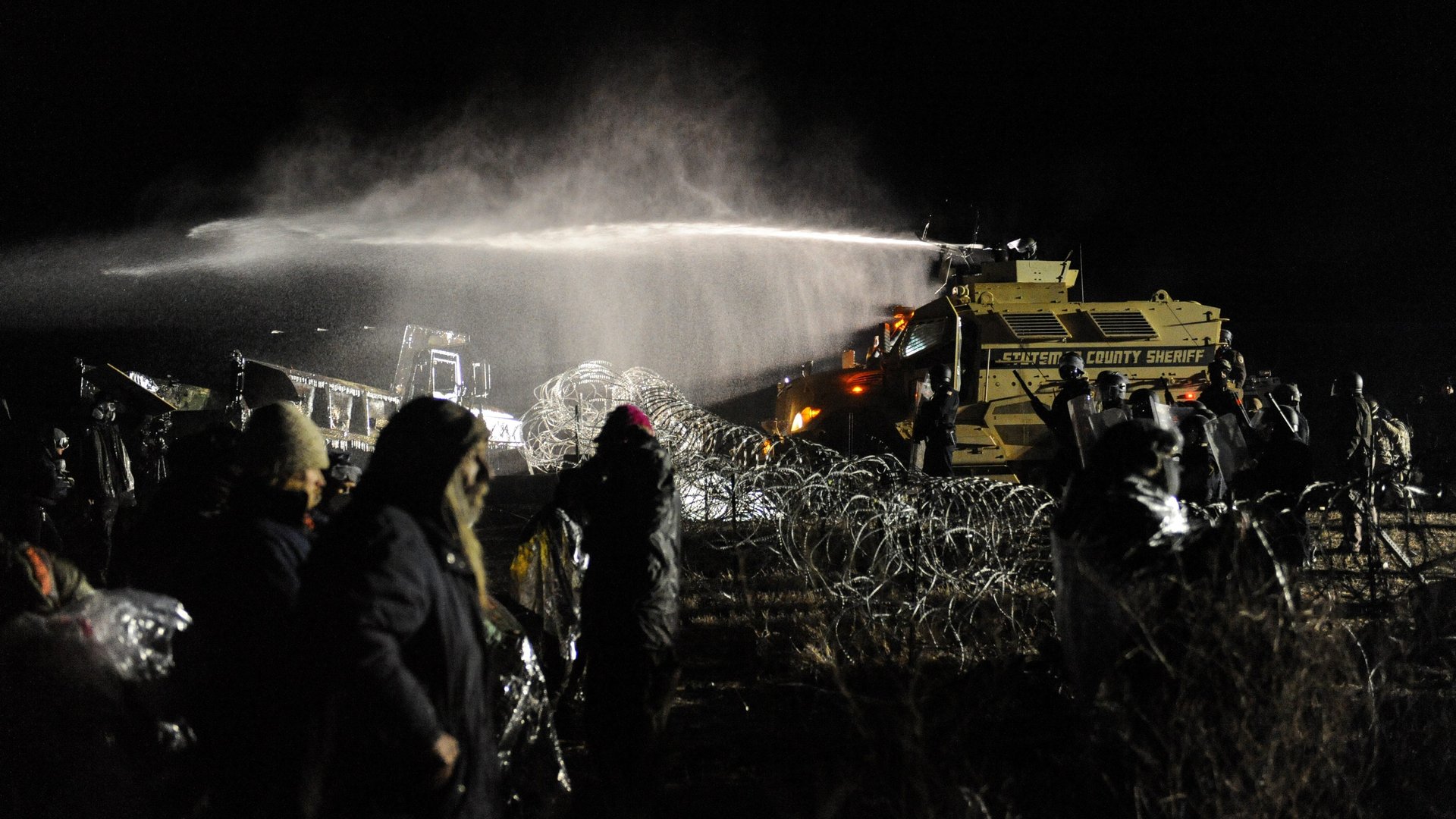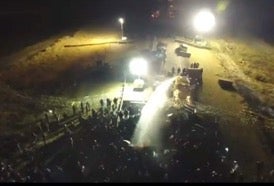The media’s Standing Rock problem looks a lot like its Black Lives Matter problem
On Sunday evening (Nov. 20), around 400 people gathered on Highway 1806, just north of the Oceti Sakowin camp at Standing Rock, North Dakota, one of the centers of the ongoing actions taken against the Dakota Access Pipeline. It was shaping up to be an ordinary demonstration; participants were moving the burnt-out trucks police were using to block a highway (and inflow of supplies to camp) out of the way, while chanting the camp’s motto: “Water is life!”


On Sunday evening (Nov. 20), around 400 people gathered on Highway 1806, just north of the Oceti Sakowin camp at Standing Rock, North Dakota, one of the centers of the ongoing actions taken against the Dakota Access Pipeline. It was shaping up to be an ordinary demonstration; participants were moving the burnt-out trucks police were using to block a highway (and inflow of supplies to camp) out of the way, while chanting the camp’s motto: “Water is life!”
Water has been at the center of the #NODAPL movement. If the Dakota Access Pipeline, DAPL for short, breaks—a near-certainty, whether it’s now or decades into use—the water of the Sioux and all neighboring people will be polluted with oil.
The citizens began to move the trucks; then, predictably, the police showed up. As in many instances before, they brought guns with rubber bullets, mace, and tear gas. Unlike before, however, they carried a new weapon: water cannons.
They faced the protectors, who have been relying on dry clothing and down sleeping bags to survive through the subzero nights in tents and teepees. Then, in 27° F weather, the police hosed down the already-shivering crowd. They continued to do so for hours, and by the morning, camp medics were reporting 167 injuries, including seven traumatic head injuries. Dozens shook with hypothermia. The nearby town opened up a gymnasium for the most severely afflicted.
By the end of the night, most major media outlets had covered the events on the bridge. “Standing Rock protest: hundreds clash with police over Dakota Access Pipeline,” wrote the Guardian. “Police, citing ‘ongoing riot,’ use water cannons on Dakota Access protesters in freezing weather,” wrote the Washington Post (the paper later changed their headline to “Police defend use water cannons on Dakota Access protesters in freezing weather”). Time’s story simply declared: “Clashes at Dakota Access Pipeline.”
The stories beneath these headlines were mostly honest and didn’t let the police off the hook. But the news organizations still made a mistake, that, while not malicious, did undermine the people whose story they sought to tell.
Ever since the movement began in April, the founders and leaders at Oceti Sakowin camp have asked that they not be referred to as protestors. They ask, instead, to be called “water protectors.” When I visited Standing Rock last week, I was told this multiple times, both during my mandatory press briefing and during a newcomer’s orientation. This request, even after it is published in a given outlet, is not usually honored; when the title “water protectors” is used, it’s usually as a supplementary gesture deep down in the story, and attributed as a request, not as a direct reference.
Last night was no different. The press did not write about a prayer, or an action, but about a “protest.” What’s more, they referred to the event as a “clash.” In reality, the actions caught on camera last night demonstrated an act of brutal violence inflicted on one group by another. A more appropriate word would have been “attack.” A more appropriate phrase: “state-sanctioned violence.”

In a recent essay for The New York Times, “Who Gets to Write What?” novelist Kaitlyn Greenidge argues that a person from one background can and should write stories about another—provided they take the time and energy to understand their characters, “to afford [them] the same depth of humanity and interest and nuance to characters who look like them as characters who don’t, to take those stories seriously and actually think about power when writing.” In short, to respect the subjects of stories as people and not just placeholders or action figures.
Though Greenidge is writing primarily about fiction, her words are useful for those in the business of mainstream media, where the workforce is overwhelmingly white. As of 2014, only 13% of journalists were from a minority group—any minority group. Short of a serious overhaul to include more journalists of diverse cultures, economic backgrounds and identities, media outlets need to at least take pains to make sure they’re representing and honoring those voices—and how they would tell their own stories.
From this standpoint, characterizing the actions of the Standing Rock Sioux and their allies as “protests” is insufficient. Likewise, by mischaracterizing this event as a two-sided “clash” rather than an act of police brutality, media outlets lend validity to actions taken by a law enforcement regiment that has locked up water protectors—who up to this point have engaged without violence—in dog cages, maced, and tear-gassed them.
The sides are not equal. While police officers are denying they used excessive force, the UN has already condemned the police attacks as such. And that was on November 15, five days before this latest escalation.
The best way to understand the problems with the way language has been deployed in covering #NODAPL is in comparison to the history of “false balance” in climate change journalism. For a long time, nearly equal weight was given to climate change deniers despite the overwhelming scientific consensus that climate change is real and caused by human activity. This false balance problem perpetuated a nationwide norm of confusion and misinformation on the state of climate change—one that continues to stunt necessary nationwide reforms and actions against the growing threat that the phenomenon poses to our environment.
The focus of many journalists has since shifted to covering scientific misinformation around climate change, and while the gap between the predominating narrative and the reality persists to this day, it’s narrowing by the year; according to a 2016 Gallup poll conducted this March, at least 64% of Americans are concerned about global climate change, up from 55% in 2015.
With #NODAPL, many news stories have lent the narrative communicated by police—that “protesters” are lighting fires on highways and acting violently—nearly equal weight to that told by the water protectors. Just as in climate change, evidence on one side is overwhelming. Numerous videos show peaceful citizens getting sprayed for prolonged periods of time; one drone video shows a water cannon attempting to shoot it down.
Yet as the North Dakota police force continues to violently attack the explicitly nonviolent protestors, many stories paint both sides as aggressive through subtle instances of language. By using words like “clash” and “riot,” these stories implicitly portray activists as committing violence, and police actions as warranted acts of self-defense, legitimizing and normalizing increasing levels of state-sanctioned violence.
This, of course, is not limited to #NODAPL. It happens often in media portrayals of people of color, specifically black Americans: After the Alton Sterling was shot and killed by police, media outlets chose to publish stories that highlighted the victim’s arrest record and mugshot, despite no evidence that Sterling posed a threat to police at the time he was shot down. Writing for Mic, Zak Cheney Rice notes that journalists tend to refer to large groups of black people taking to the streets in emotional outbursts as “rioters,” “looters,” and “thugs,” while they tend to label large groups of white people doing the same things—sometimes far more destructively—as “revelers,” “celebrants,” and “fans.”
Writing for Indian Country Today Network in September, Mark Trahant noted that the way language frames the #NODAPL movement is just as important as the movement itself: “This is a fight about story,” he writes. “And who gets to tell it.”
Trahant’s words take on even more meaning today, in the post-election political climate. During Donald Trump’s presidential campaign, journalists and concerned citizens remarked that the attempt to cover Trump and his supporters in a “balanced” manner would potentially rationalize positions that might’ve been considered unthinkably cruel, racist, or irrational pre-Trump. For example, Nicole Silverberg, a comedian and writer, has called for CNN to stop referring to the “alt-right” party by its preferred name, arguing that the title conceals the party’s white nationalist, racist, and homophobic agenda. “It is unacceptable,” Silverberg wrote on Facebook. “The media must be held accountable.”
Others argue that since the “alt-right” is the name the party has given themselves, we should refer to them that way. By that logic, however, shouldn’t the people at #NODAPL be referred to by “water protectors” rather than protestors?